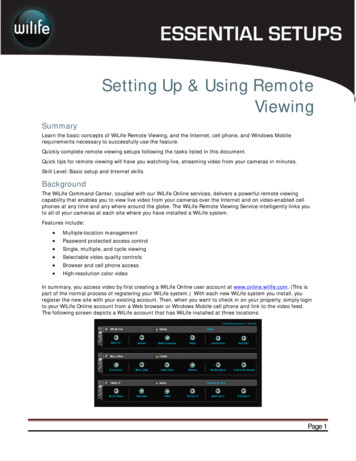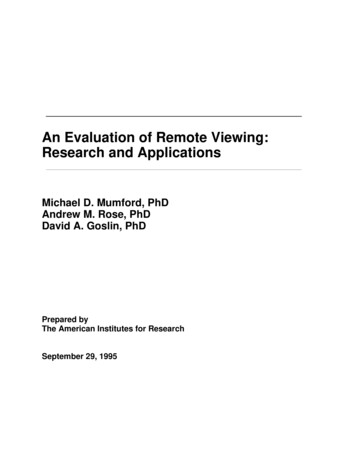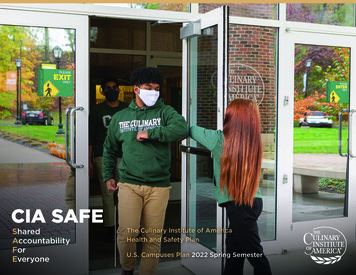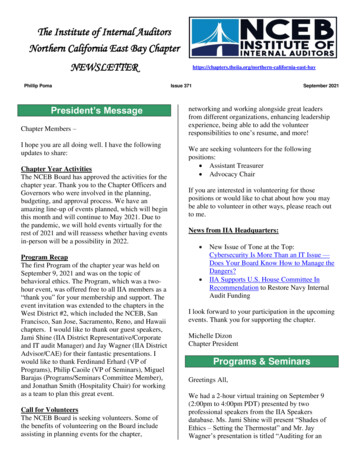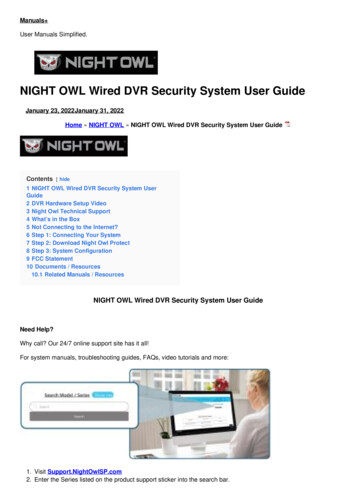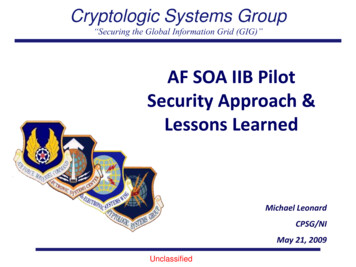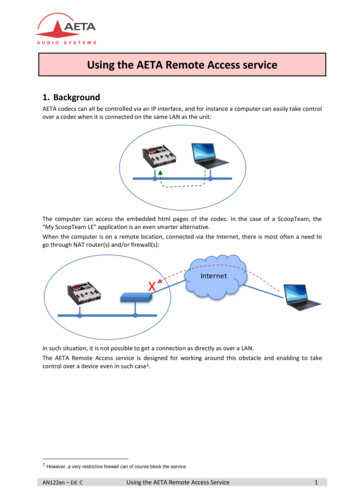
Transcription
Journal of Scientijc Exploration, Vol. 10, No. 1, pp. 63-76, 19960892-33 10196O 1996 Society for Scientific ExplorationCIA-Initiated Remote Viewing Programat Stanford Research InstituteH. E. PUTHOFFInstitute for Advanced Studies at Austin, 4030 Braker Lane W ,Ste. 300, Austin, TX 78759,Abstract - In July 1995 the CIA declassified, and approved for release,documents revealing its sponsorship in the 1970s of a program at StanfordResearch Institute in Menlo Park, CA, to determine whether such phenomenaas remote viewing "might have any utility for intelligence collection".' Thusbegan disclosure to the public of a two-decade-plus involvement of the intelligence community in the investigation of so-called parapsychological or psiphenomena. Presented here by the program's Founder and first Director(1972-1985) is the early history of the program, including discussion of someof the first, now declassified, results that drove early interest.IntroductionOn April 17, 1995, President Clinton issued Executive Order Nr. 1995-4-17,entitled Classified National Security Information. Although in one sense theorder simply reaffirmed much of what has been long-standing policy, in another sense there was a clear shift toward more openness. In the opening paragraph, for example, we read: "In recent years, however, dramatic changes havealtered, although not eliminated, the national security threats that we confront. These changes provide a greater opportunity to emphasize our commitment to open Government." In the Classification Standards section of theOrder this commitment is operationalized by phrases such as "If there is significant doubt about the need to classify information, it shall not be classified." Later in the document, in reference to information that requires continued protection, there even appears the remarkable phrase "In someexceptional cases, however, the need to protect such information may be outweighed by the public interest in disclosure of the information, and in thesecases the information should be declassified."A major fallout of this reframing of attitude toward classification is thatthere is enormous pressure on those charged with maintaining security to workhard at being responsive to reasonable requests for disclosure. One of the results is that FOIA (Freedom of Information Act) requests that have languishedfor months to years are suddenly being acted upon.2One outcome of this change in policy is the government's recent admission'From "CIA Statement on 'Remote Viewing'," CIA Public Affairs Office, 6 September 1995.'One example being the release of documents that are the subject of this report - see the memoir byRussell Targ elsewhere in this volume.
64H. E. Puthoffof its two-decade-plus involvement in funding highly-classified, special access programs in remote viewing (RV) and related psi phenomena, first atStanford Research Institute (SRI) and then at Science Applications International Corporation (SAIC), both in Menlo Park, CA, supplemented by variousin-house government programs. Although almost all of the documentation remains yet classified, in July 1995, 270 pages of SRI reports were declassifiedand released by the CIA, the program's first sponsor (Puthoff & Targ,1974-5)3. Thus, although through the years columns by Jack Anderson andothers had claimed leaks of "psychic spy" programs with such exotic names asGrill Flame, Center Lane, Sunstreak and Star Gate, CIA'S release of the SRIreports constitutes the first documented public admission of significant intelligence community involvement in the psi area.As a consequence of the above, although I had founded the program in early1972, and had acted as its Director until I left in 1985 to head up the Institutefor Advanced Studies at Austin (at which point my colleague Ed May assumedresponsibility as Director), it was not until 1995 that I found myself for thefirst time able to utter in a single sentence the connected acronymsCIAISRIIRV. In this report I discuss the genesis of the program, report onsome of the early, now declassified, results that drove early interest, and outline the general direction the program took as it expanded into a multi-year,multi-site, multi-million-dollar effort to determine whether such phenomenaas remote viewing "might have any utility for intelligence collection" (seefootnote 1).BeginningsIn early 1972 I was involved in laser research at Stanford Research Institute(now called SRI International) in Menlo Park, CA. At that time I was also circulating a proposal to obtain a small grant for some research in quantum biology. In that proposal I had raised the issue whether physical theory as weknew it was capable of describing life processes, and had suggested somemeasurements involving plants and lower organisms (Puthoff, 1972). Thisproposal was widely circulated, and a copy was sent to Cleve Backster in NewYork City who was involved in measuring the electrical activity of plants withstandard polygraph equipment. New York artist Ingo Swann chanced to seemy proposal during a visit to Backster s lab, and wrote me suggesting that if Iwere interested in investigating the boundary between the physics of the animate and inanimate, I should consider experiments of the parapsychologicaltype. Swann then went on to describe some apparently successful experimentsin psychokinesis in which he had participated at Prof. Gertrude Schmeidler slaboratory at the City College of New York. As a result of this correspondence773Thesereports cover the period January 1974 through February 1975, the second year of the program.This effort was funded at the level of 149,555.
H. E. Puthoff65I invited him to visit SRI for a week in June 1972 to demonstrate such effects,frankly, as much out of personal scientific curiosity as anything else.Prior to Swann's visit I arranged for access to a well-shielded magnetometerused in a quark-detection experiment in the Physics Department at StanfordUniversity. During our visit to this laboratory, sprung as a surprise to Swann,he appeared to perturb the operation of the magnetometer, located in a vaultbelow the floor of the building and shielded by p-metal shielding, an aluminum container, copper shielding and a superconducting shield. As if to addinsult to injury, he then went on to "remote view" the interior of the apparatus,rendering by drawing a reasonable facsimile of its rather complex (and heretofore unpublished) construction. It was this latter feat that impressed me perhaps even more than the former, as it also eventually did representatives of theintelligence community. I wrote up these observations and circulated it amongmy scientific colleagues in draft form of what was eventually published as partof a conference proceedings (Puthoff & Targ, 1975).In a few short weeks a pair of visitors showed up at SRI with the above report in hand. Their credentials showed them to be from the CIA. They knew ofmy previous background as a Naval Intelligence Officer and then civilian employee at the National Security Agency (NSA) several years earlier, and feltthey could discuss their concerns with me openly. There was, they told me, increasing concern in the intelligence community about the level of effort in Soviet parapsychology being funded by the Soviet security services4; by Westernscientific standards the field was considered nonsense by most working scientists. As a result they had been on the lookout for a research laboratory outsideof academia that could handle a quiet, low-profile classified investigation, andSRI appeared to fit the bill. They asked if I could arrange an opportunity forthem to carry out some simple experiments with Swann, and, if the testsproved satisfactory, would I consider a pilot program along these lines? Iagreed to consider this, and arranged for the requested tests.'The tests were simple, the visitors simply hiding objects in a box and askingSwann to attempt to describe the contents. The results generated in these experiments are perhaps captured most eloquently by the following example. Inone test Swann said "I see something small, brown and irregular, sort of like aleaf or something that resembles it, except that it seems very much alive, likeit's even moving!" The target chosen by one of the visitors turned out to be asmall live moth, which indeed did look like a leaf. Although not all responseswere quite so precise, nonetheless the integrated results were sufficiently im4Documented in "Paraphysics R&D - Warsaw Pact (U)," DST-1810s-202-78, Defense IntelligenccAgency (30 March 1978).5Since the reputation of the intelligence services is mixed among members of the general populace, Ihave on occasion been challenged as to why I would agree to cooperate with the CIA or other elementsof the intelligence community in this work. My answer is simply that as a result of my own previous exposure to this community I became persuaded that war can almost always be traced to a failure in intelligence, and that therefore the strongest weapon for peace is good intelligence.
66CIA Initiated Remote Viewingpressive that in short order an eight-month, 49,909 Biofield MeasurementsProgram was negotiated as a pilot study; a laser colleague, Russell Targ, whohad had a long-time interest and involvement in parapsychology joined theprogram; and the experimental effort was begun in earnest.Early Remote Viewing ResultsDuring the eight-month pilot study of remote viewing the effort graduallyevolved from the remote viewing of symbols and objects in envelopes andboxes, to the remote viewing of local target sites in the San Francisco Bay area,demarked by outbound experimenters sent to the site under strict protocols devised to prevent artifactual results. Later judging of the results were similarlyhandled by double-blind protocols designed to foil artifactual matching. Sincethese results have been presented in detail elsewhere, both in the scientific literature (Targ & Puthoff, 1974; Puthoff & Targ, 1976; and Puthoff et al., 198 1)and in popular book format (Targ & Puthoff, 1977), I direct the interested reader to these sources. To summarize, over the years the back-and-forth criticismof protocols, refinement of methods, and successful replication of this type ofremote viewing in independent laboratories (Bisaha & Dunne, 1979; Dunne &Bisaha, 1979; Jahn, 1982; and Jahn & Dunne, 1986), has yielded considerablescientific evidence for the reality of the phenomenon. Adding to the strengthof these results was the discovery that a growing number of individuals couldbe found to demonstrate high-quality remote viewing, often to their own surprise, such as the talented Hella Hammid. As a separate issue, however, mostconvincing to our early program monitors were the results now to be described, generated under their own control.First, during the collection of data for a formal remote viewing series targeting indoor laboratory apparatus and outdoor locations - a series eventuallypublished in toto in the Proc. IEEE (Puthoff & Targ, 1976) - the CIA contractmonitors, ever watchful for possible chicanery, participated as remote viewersthemselves in order to critique the protocols. In this role three separate viewers, designated visitors V1-V3 in the IEEE paper, contributed seven of the 55viewings, several of striking quality. Reference to the IEEE paper for a comparison of descriptions/drawings to pictures of the associated targets, generated by the contract monitors in their own viewings, leaves little doubt as to whythe contract monitors came to the conclusion that there was something to remote viewing (see, for example, Figure 1 herein). As summarized in the Executive Summary of the now-released Final Report (Puthoff & Targ, 1974-5) ofthe second year of the program, "The development of this capability at SRIhas evolved to the point where visiting CIA personnel with no previous exposure to such concepts have performed well under controlled laboratory conditions (that is, generated target descriptions of sufficiently high quality to permit blind matching of descriptions to targets by independent judges)." Whathappened next, however, made even these results pale in comparison.
68CIA Initiated Remote ViewingCoordinate Remote ViewingTo determine whether it was necessary to have a "beacon" individual at thetarget site, Swann suggested carrying out an experiment to remote view theplanet Jupiter before the upcoming NASA Pioneer 10 flyby. In that case, muchto his chagrin (and ours) he found a ring around Jupiter, and wondered if perhaps he had remote viewed Saturn by mistake. Our colleagues in astronomywere quite unimpressed as well, until the flyby revealed that an unanticipatedring did in fact exist.6Expanding the protocols yet further, Swann proposed a series of experiments in which the target was designated not by sending a "beacon" person tothe target site, but rather by the use of geographical coordinates, latitude andlongitude in degrees, minutes and seconds. Needless to say, this proposalseemed even more outrageous than "ordinary" remote viewing. The difficulties in taking this proposal seriously, designing protocols to eliminate the possibility of a combination of globe memorization and eidetic or photographicmemory, and so forth, are discussed in considerable detail elsewhere (Targ andPuthoff, 1977). Suffice it to say that investigation of this approach, which wedesignated Scanate (scanning by coordinate), eventually provided us with sufficient evidence to bring it up to the contract monitors and suggest a test undertheir control. A description of that test and its results, carried out in mid-1973during the initial pilot study, are best presented by quoting directly from theExecutive Summary of the Final Report of the second year's followup program. The remote viewers were Ingo Swann and Pat Price, and the entire transcripts are available in the released documents (Puthoff & Targ, 1974-5).In order to subject the remote viewing phenomena to a rigorous long-distance test underexternal control, a request for geographical coordinates of a site unknown to subjectand experimenters was forwarded to the OSI group responsible for threat analysis inthis area. In response, SRI personnel received a set of geographical coordinates (latitude and longitude in degrees, minutes, and seconds) of a facility, hereafter referred toas the West Virginia Site. The experimenters then carried out a remote viewing experiment on a double-blind basis, that is, blind to experimenters as well as subject. The experiment had as its goal the determination of the utility of remote viewing under conditions approximating an operational scenario. Two subjects targeted on the site, asensitive installation. One subject drew a detailed map of the building and grounds layout, the other provided information about the interior including codewords, data subsequently verified by sponsor sources (report available from COTR ).7Since details concerning the site's mission in general8, and evaluation of theremote viewing test in particular, remain highly classified to this day, all that6Thisresult was published by us in advance of the ring's discovery (Targ & Puthoff, 1977).'COTR - Contracting Officer's Technical Representative.*An NSA listening post at the Navy's Sugar Grove facility, according to intelligence-communitychronicler Bamford (1983).
H. E. Puthoff69can be said is that interest in the client community was heightened considerably following this exercise.Because Price found the above exercise so interesting, as a personal challenge he went on to scan the other side of the globe for a Communist Blocequivalent and found one located in the Urals, the detailed description ofwhich is also included in Puthoff & Targ (1974-5). As with the West VirginiaSite, the report for the Urals Site was also verified by personnel in the sponsororganization as being substantially correct.What makes the West VirginiaIUrals Sites viewings so remarkable is thatthese are not best-ever examples culled out of a longer list; these are literallythe first two site-viewings carried out in a simulated operational-type scenario.In fact, for Price these were the very first two remote viewings in our programaltogether, and he was invited to participate in yet further experimentation.Operational Remote Viewing (Semipalatinsk, USSR)Midway through the second year of the program (July 1974) our CIA sponsor decided to challenge us to provide data on a Soviet site of ongoing operational significance. Pat Price was the remote viewer. A description of the remote viewing, taken from our declassified final report (Puthoff & Targ,1974-5), reads as given below. I cite this level of detail to indicate the thoughtthat goes into such an "experiment" to minimize cueing while at the same timebeing responsive to the requirements of an operational situation. Again, this isnot a "best-ever" example from a series of such viewings, but rather the veryfirst operational Soviet target concerning which we were officially tasked.To determine the utility of remote viewing under operational conditions, a long-distance remote viewing experiment was carried out on a sponsor-designated target of current interest, an unidentified research center at Semipalatinsk, USSR.This experiment, carried out in three phases, was under direct control of the COTR.To begin the experiment, the COTR furnished map coordinates in degrees, minutes andseconds. The only additional information provided was the designation of the target asan R&D test facility. The experimenters then closeted themselves with Subject S1,gave him the map coordinates and indicated the designation of the target as an R&D testfacility. A remote-viewing experiment was then carried out. This activity constitutedPhase I of the experiment.Figure 2(a) shows the subject's graphic effort for building layout; Figure 2(b) showsthe subject's particular attention to a multistory gantry crane he observed at the site.Both results were obtained by the experimenters on a double-blind basis before exposure to any additional COTR-held information, thus eliminating the possibility of cueing. These results were turned over to the client representatives for evaluation. For comparison an artist's rendering of the site as known to the COTR (but not to theexperimenters until later) is shown in Figure 3.Were the results not promising, the experiment would have stopped at this point. Description of the multistory crane, however, a relatively unusual target item, was takenas indicative of possible target acquisition. Therefore, Phase I1 was begun, defined bythe subject being made "witting" (of the client) by client representatives who introduced themselves to the subject at that point; Phase I1 also included a second round of
CIA Initiated Remote ViewingUNCLASSIFIEDFig. 2(a). Subject effort at building layout.Fig. 2(b). Subject effort at crane construction.UNCLASSIFIED
72CIA Initiated Remote ViewingFig. 4. Left to rlght: Christopher Green, Pat Price, and Hal Puthoff. Picture taken following a successful experiment involving glider-ground RV.experimentation on the Semipalatinsk site with direct participation of client representatives in which further data were obtained and evaluated. As preparation for this phase,client representatives purposely kept themselves blind to all but general knowledge ofthe target site to minimize the possibility of cueing. The Phase I1 effort was focused onthe generation of physical data that could be independently verified by other clientsources, thus providing a calibration of the process.The end of Phase I1 gradually evolved into the first part of Phase 111, the generationof unverifiable data concerning the Semipalatinsk site not available to the client, but ofoperational interest nonetheless. Several hours of tape transcript and a notebook ofdrawings were generated over a two-week period.The data describing the Semipalatinsk site were evaluated by the sponsor, and arecontained in a separate report. In general, several details concerning the salient technology of the Semipalatinsk site appeared to dovetail with data from other sources, anda number of specific large structural elements were correctly described. The resultscontained noise along with the signal, but were nonetheless clearly differentiated fromthe chance results that were generated by control subjects in comparison experimentscarried out by the COTR.For discussion of the ambiance and personal factors involved in carrying outthis experiment, along with further detail generated as Price (see Figure 4)"roamed" the facility, including detailed comparison of Price's RV-generatedinformation with later-determined "ground-truth reality," see the accornpanying article by Russell Targ in this volume.Additional experiments having implications for intelligence concerns were
H. E. Puthoff73carried out, such as the remote viewing of cipher-machine type apparatus, andthe RV-sorting of sealed envelopes to differentiate those that contained letterswith secret writing from those that did not. To discuss these here in detailwould take us too far afield, but the interested reader can follow up by referringto the now-declassified project documents (Puthoff & Targ, 1974-5).Follow-on ProgramsThe above discussion brings us up to the end of 1975. As a result of the material being generated by both SRI and CIA remote viewers, interest in the program in government circles, especially within the intelligence community, intensified considerably and led to an ever-increasing briefing schedule. This inturn led to an ever-increasing number of clients, contracts and tasking, andtherefore expansion of the program to a multi-client base, and eventually to anintegrated joint-services program under single-agency (DIA )leadership. Tomeet the demand for the increased level of effort we first increased our professional staff by inviting Ed May to join the program in 1976, then screened andadded to the program a cadre of remote viewers as consultants, and let subcontracts to increase our scope of activity.As the program expanded, in only a very few cases could the clients' identities and program tasking be revealed. Examples include a NASA-funded studynegotiated early in the program by Russ Targ to determine whether the internalstate of an electronic random-number-generator could be detected by RVprocesses (Targ et al., 1974), and a study funded by the Naval Electronics Systems Command to determine whether attempted remote viewing of distantlight flashes would induce correlated changes in the viewer's brainwave (EEG)production (Targ et al., 1978). For essentially all other projects during my 14year tenure at SRI, however, the identity of the clients and most of the taskingwere classified and remain so today. (The exception was the occasional privately-funded study.) We are told, however, that further declassification andrelease of much of this material is almost certain to occur.What can be said, then, about further development of the program in the twodecades following 1975?1 In broad terms it can be said that much of the SRIeffort was directed not so much toward developing an operational U.S. capability, but rather toward assessing the threat potential of its use against theU.S. by others. The words "threat assessment" were often used to describe theprogram's purpose during its development, especially during the early years.As a result much of the remote-viewing activity was carried out under conditions where ground-truth reality was a priori known or could be determined,such as the description of U.S. facilities and technological developments, thetiming of rocket test firings and underground nuclear tests, and the location of9DIA- Defense Intelligence Agency. The CIA dropped out as a major player in the mid-seventies dueto pressure on the Agency (unrelated to the RV Program) from the Church-Pike Congressional Committee.''See also the contribution of Ed May elsewhere in this volume concerning his experiences from 1985on during his tenure as Director.
74CIA Initiated Remote Viewingindividuals and mobile units. And, of course, we were responsive to requeststo provide assistance during such events as the loss of an airplane or the takingof hostages, relying on the talents of an increasing cadre of remoteviewerlconsultants, some well-known in the field such as Keith Harary, andmany who have not surfaced publicly until recently, such as Joe McMoneagle.One might ask whether in this program RV-generated information was everof sufficient significance as to influence decisions at a policy level. This is ofcourse impossible to determine unless policymakers were to come forwardwith a statement in the affirmative. One example of a possible candidate is astudy we performed at SRI during the Carter-administration debates concerning proposed deployment of the mobile MX missile system. In that scenariomissiles were to be randomly shuffled from silo to silo in a silo field, in a formof high-tech shell game. In a computer simulation of a twenty-silo field withrandomly-assigned (hidden) missile locations, we were able, using RV-generated data, to show rather forcefully that the application of a sophisticated statistical averaging technique (sequential sampling) could in principle permit anadversary to defeat the system. I briefed these results to the appropriate officesat their request, and a written report with the technical details was widely circulated among groups responsible for threat analysis (Puthoff, 1979), and withsome impact. What role, if any, our small contribution played in the mix offactors behind the enormously complex decision to cancel the program willprobably never be known, and must of course apriori be considered in all likelihood negligible. Nonetheless, this is a prototypical example of the kind oftasking that by its nature potentially had policy implications.Even though the details of the broad range of experiments, some brilliantsuccesses, many total failures, have not yet been released, we have nonethelessbeen able to publish summaries of what was learned in these studies about theoverall characteristics of remote viewing, as in Table 5 of Puthoff et al. (1981).Furthermore, over the years we were able to address certain questions of scientific interest in a rigorous way and to publish the results in the open literature.Examples include the apparent lack of attenuation of remote viewing due toseawater shielding (submersible experiments) (Puthoff et al., 198 l), the amplification of RV performance by use of error-correcting coding techniques(Puthoff, 1985; Puthoff, 1986), and the utility of a technique we call associational remote viewing (ARV) to generate useful predictive information(Puthoff, 1984).11As a sociological aside, we note that the overall efficacy of remote viewingin a program like this was not just a scientific issue. For example, when theSemipalatinsk data described earlier was forwarded for analysis, one group declined to get involved because the whole concept was deemed unscientificnonsense, while a second group declined because, even though it might bereal, it was possibly demonic; a third group had to be found. And, as in the case"For example, one application of this technique yielded not only a published, statistically significantresult, but also a return of 26,000 in 30 days in the silver futures market (Puthoff, 1984).
H. E. Puthoff75of public debate about such phenomena, the program's image was on occasionas likely to be damaged by an overenthusiastic supporter as by a detractor. Personalities, politics and personal biases were always factors to be dealt with.Official Statements/PerspectivesWith regard to admission by the government of its use of remote viewersunder operational conditions, officials have on occasion been relatively forthcoming. President Carter, in a speech to college students in Atlanta in September 1995, is quoted by Reuters as saying that during his administration a planewent down in Zaire, and a meticulous sweep of the African terrain by American spy satellites failed to locate any sign of the wreckage. It was then "without my knowledge" that the head of the CIA (Adm. Stansfield Turner) turnedto a woman reputed to have psychic powers. As told by Carter, "she gave somelatitude and longitude figures. We focused our satellite cameras on that pointand the plane was there." Independently, Turner himself also has admitted theAgency's use of a remote viewer (in this case, Pat price).I2 And recently, in asegment taped for the British television series q u i n o x ' Maj.,Gen. EdThompson, Assistant Chief of Staff for Intelligence, U.S. Army (1977-1981),volunteered "I had one or more briefings by SRI and was impressed . The decision I made was to set up a small, in-house, low-cost effort in remote viewing."Finally, a recent unclassified report (Mumford et al., 1995) prepared for theCIA by the American Institutes for Research (AIR), concerning a remoteviewing effort carried out under a DIA program called Star Gate (discussed indetail elsewhere in this volume), cites the roles of the CIA and DIA in the history of the program, including acknowledgment that a cadre of full-time government employees used remote viewing techniques to respond to tasking fromoperational military organizations.14As information concerning the various programs spawned by intelligencecommunity interest is released, and the dialog concerning their scientific andsocial significance is joined, the results are certain to be hotly debated. Bearing witness to this fact are the companion articles in this volume by Ed May,Director of the SRI and SAIC programs since 1985, and by Jessica Utts andRay Hyman, consultants on the AIR evaluation cited above. These articles address in part the AIR study. That study, limited in scope to a small fragment ofthe overall program effort, resulted in a conclusion tha
Journal of Scientijc Exploration, Vol. 10, No. 1, pp. 63-76, 1996 0892-33 10196 O 1996 Society for Scientific Exploration CIA-Initiated Remote Viewing Program at Stanford Research Institute H. E. PUTHOFF Institute for Advanced Studies at Austin, 4030 Braker Lane W, Ste. 300, Austin, TX 78759 Abstract - In July 1995 the CIA declassified, and approved for release,
